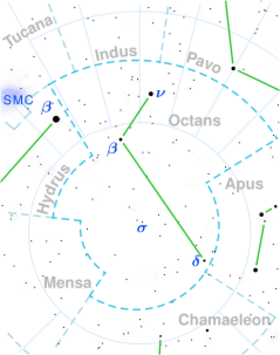Astronomy:Delta Octantis
From HandWiki
Short description: Star in the constellation Octans
| Observation data Equinox J2000.0]] (ICRS) | |
|---|---|
| Constellation | Octans |
| Right ascension | 14h 26m 55.23244s[1] |
| Declination | −83° 40′ 04.3868″[1] |
| Apparent magnitude (V) | 4.31[2] |
| Characteristics | |
| Spectral type | K2III[3] |
| U−B color index | +1.45[4] |
| B−V color index | +1.31[4] |
| Astrometry | |
| Radial velocity (Rv) | +4.60[5] km/s |
| Proper motion (μ) | RA: -96.12[1] mas/yr Dec.: -13.27[1] mas/yr |
| Parallax (π) | 10.91 ± 0.14[1] mas |
| Distance | 299 ± 4 ly (92 ± 1 pc) |
| Absolute magnitude (MV) | −0.35 ± 0.09[6] |
| Details | |
| Mass | 1.06[5] M☉ |
| Radius | 24.61[5] R☉ |
| Luminosity | 271[2] L☉ |
| Surface gravity (log g) | 1.89[5] cgs |
| Temperature | 4,311[5] K |
| Metallicity [Fe/H] | -0.42[5] dex |
| Rotational velocity (v sin i) | 1.1[7] km/s |
| Other designations | |
CD-83 189, GC 19349, HIP 70638, HR 5339, HD 124882, NSV 6636, SAO 258698 | |
| Database references | |
| SIMBAD | data |
δ Octantis, Latinised as Delta Octantis, has the distinction of being Saturn's southern pole star.[8] An orange giant of class K2III,[3] it has 1.2 times the mass of the Sun and about 25 times the Sun's radius. This star is about 4.3 billion years old, which is similar to the age of the Sun.[6]
Naming
In Chinese caused by adaptation of the European southern hemisphere constellations into the Chinese system, 異雀 (Yì Què), meaning Exotic Bird, refers to an asterism consisting of δ Octantis, ζ Apodis, ι Apodis, β Apodis, γ Apodis, δ1 Apodis, η Apodis, α Apodis and ε Apodis. Consequently, δ Octantis itself is known as 異雀五 (Yì Què wǔ, English: the Fifth Star of Exotic Bird).[9]
References
- ↑ 1.0 1.1 1.2 1.3 1.4 Van Leeuwen, F. (2007). "Validation of the new Hipparcos reduction". Astronomy and Astrophysics 474 (2): 653–664. doi:10.1051/0004-6361:20078357. Bibcode: 2007A&A...474..653V. Vizier catalog entry
- ↑ 2.0 2.1 Anderson, E.; Francis, Ch. (2012). "XHIP: An extended hipparcos compilation". Astronomy Letters 38 (5): 331. doi:10.1134/S1063773712050015. Bibcode: 2012AstL...38..331A. Vizier catalog entry
- ↑ 3.0 3.1 Hoffleit, D.; Warren, W. H. (1995). "VizieR Online Data Catalog: Bright Star Catalogue, 5th Revised Ed. (Hoffleit+, 1991)". VizieR On-line Data Catalog: V/50. Originally Published in: 1964BS....C......0H 5050. Bibcode: 1995yCat.5050....0H.
- ↑ 4.0 4.1 Mallama, A. (2014). "Sloan Magnitudes for the Brightest Stars". The Journal of the American Association of Variable Star Observers 42 (2): 443. Bibcode: 2014JAVSO..42..443M.Vizier catalog entry
- ↑ 5.0 5.1 5.2 5.3 5.4 5.5 Jofré, E.; Petrucci, R.; Saffe, C.; Saker, L.; Artur de la Villarmois, E.; Chavero, C.; Gómez, M.; Mauas, P. J. D. (2015). "Stellar parameters and chemical abundances of 223 evolved stars with and without planets". Astronomy & Astrophysics 574: A50. doi:10.1051/0004-6361/201424474. Bibcode: 2015A&A...574A..50J. Vizier catalog entry
- ↑ 6.0 6.1 da Silva, L. et al. (November 2006), "Basic physical parameters of a selected sample of evolved stars", Astronomy and Astrophysics 458 (2): 609–623, doi:10.1051/0004-6361:20065105, Bibcode: 2006A&A...458..609D
- ↑ De Medeiros, J. R.; Alves, S.; Udry, S.; Andersen, J.; Nordström, B.; Mayor, M. (2014). "A catalog of rotational and radial velocities for evolved stars". Astronomy & Astrophysics 561: A126. doi:10.1051/0004-6361/201220762. Bibcode: 2014A&A...561A.126D. Vizier catalog entry
- ↑ "Octans". UK Astronomy Society. http://www.topastronomer.com/StarCharts/Constellations/Octans.php.
- ↑ (in Chinese) AEEA (Activities of Exhibition and Education in Astronomy) 天文教育資訊網 2006 年 7 月 29 日
 |


